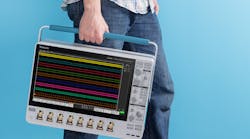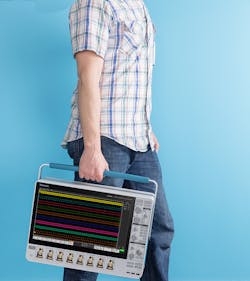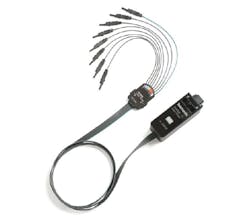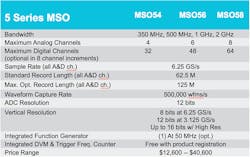Tektronix is on fire. The company just announced the 5 Series MSO, a complete mid-range oscilloscope redesign that pulled “ooohs” and “aaahs” from the smiling mouths of many who are ready for something new, creative, and useful. The new scope provides all that, and then some.
The last time Tektronix managed to pull me from my burrow was only a few weeks ago, when it came to show off the AWG5200 arbitrary waveform generator. While that was an exercise in performance, precision, and integration, the 5 Series MSO is a breakthrough in usability. That’s a simple word, but it sums up the scope’s flexibility, performance, portability, capability, and ease of use.
The demonstration started off with a video of “the big reveal” in front of engineers, who were the ones “ooohing” and “aaahing” like little kids. I figured the demo would be good, but it’s not often you see “jaded” engineers behave like this, so my curiosity was further piqued.
Gary Waldo, product planner for Tektronix, was on hand to do the big reveal for yours truly, but first he hit me with the reasoning behind the scope, and some performance details. I’ll do the opposite. Here’s Waldo giving a run-through of the 5 Series MSO on video, because that’s the only way to fully appreciate the visual nature of the system and its touchscreen interface:
And here’s a shot from Tektronix that provides some physical perspective on its portability (Fig. 1).
1. The 5 Series MSO is a 2-GHz, 6.25-Gsample/s mixed-signal oscilloscope that combines up to eight FlexChannels with an HD display designed for touch-based interfacing. It weighs less than 25 lb. and can boot into Windows with the added hard disk. (Source: Tektronix)
On pulling back the cover, Waldo revealed a scope that 85% screen and 15% control panel. The screen is 15.6 inches (diagonal), has a resolution of 1920 × 1080, and its capacitive touchscreen takes full advantage of the usefulness of touch. To appreciate how this works and how it makes the scope stand out, go to time point 2 min. and 15 sec. [2:15] in the video.
Once there, you’ll see how the controls and knobs on the panel are color-coordinated with the channels on the screen. Then at time point 3:15, you’ll see how you can zoom, pan, pull, stretch, and drag waveforms, with a graticule that moves with the waveform. Therefore, you won’t lose track of your channel and waveform parameters as you manipulate your views.
Tektronix really did focus on helping users keep track of and clearly view waveforms, to the extent that it added a new Stacked display mode. Unlike traditional viewing of multiple waveforms, all waveforms now can be observed clearly, without overlapping, and at the full ADC range for the waveform for maximum accuracy. To see how this Stacked feature works and looks, go to time point 4:14 on the video.
The second-most-obvious feature on the 5 Series MSO is the channel inputs, called FlexChannels. They are completely redesigned inputs—each can be either one analog input or eight digital inputs, with the choice being made as soon as the appropriate connector is inserted. Any mix of digital or analog can be used; the scope comes in four-, six-, or eight-channel versions.
2. The TLP058 probes convert any FlexChannel to an eight-input digital channel. See time point 2:15 on the video to see how easy it is for the inputs to convert. It costs $1,800. (Source: Tektronix)
According to Waldo, this overcomes the typical limitation of four analog channels as they work on problems involving three-phase power, such as motor control and inverters, as well as automotive electronics. “Often they need more than one scope and then have to synch scopes from different manufacturers,” he said.
Go to time point 2:15 on the video to see how easily the $1,800 TLP058 digital probes switch in to convert what was an analog FlexChannel input to an eight-input digital channel (Fig. 2). Note that the VPI connection does accept existing probes, so don’t panic. Also, the 5 Series comes with one TPP Series passive voltage probe to match the bandwidth.
The 5 Series comes in three versions, and along with the number of channels, the key differentiator is the bandwidth, which ranges from 350 MHz to 2 GHz. Other key specs include a sample rate of 6.25 Gsamples/s, a 12-bit analog-to-digital converter, and a waveform capture rate of >500,000 waveforms/s (Fig. 3).
3. The number of channels and the bandwidth are the key differentiators among the three variations of 5 Series MSOs. The cost for six- and eight-channel versions is only approximately 25% and 67% more than four channels, respectively. (Source: Tektronix)
Multiple Instruments and Windows OS
One of the calling cards of the 5 Series is that it can be multiple instruments in one, including a logic analyzer, 50-MHz arbitrary waveform generator, digital voltmeter, protocol analyzer, and trigger frequency counter. However, it also has the option of booting into Windows.
There’s a hatch under the instrument into which a hard drive can be inserted. Once installed, the system boots into Windows OS and any Windows application can be run on the machine. If the hard drive isn’t present, it defaults to a dedicated scope.
If you go to time point 1:30, you’ll see where and how to add the Windows-based hard drive. You’ll also see a feature of the scope’s legs: They don’t collapse when the scope is moved or leaned forward, like when you go to access the rear comm ports. It’s actually a pretty neat little trick performed by the designers.
Great Improvement that Begs for More
The 5 Series MSO advances the state of the art in instrument usability, as well as looks. The HD display is stunning, to say the least. For anyone with vision issues, the screen is a welcome relief from smaller displays with overlapping waveforms and tiny numbers. The ability to quickly zoom in and out and otherwise manipulate waveforms in true touch style, with context-sensitive menus accessed by tapping the point of interest, is an excellent plus.
Beyond setting a new standard for practical usability, the takeaway with the 5 Series MSO is that it opens the imagination to what can be done with regard to user interfaces. Knobs and buttons are great, but a fully optimized and context-aware touchscreen can be so much more efficient.
Of course, in situations where you have two hands occupied probing a board or system, my immediate thought was that voice control would be very useful. Waldo said that Tektronix had tried that before, but the technology at the time was less advanced than it is today. So who knows, they might try it again.
Another option is 3D gesture control, using Ultrahaptics' technology. Combined with voice recognition, that could be a really interesting approach to advancing the state of the art in instrumentation user interfaces. What do you think?
Here’s a list of time points in the video for each of the key visual features mentioned here (minutes:seconds):
1:30 Windows and hard-drive installation.
1:50 Foot action: legs don’t collapse when moving scope.
2:15 See how channels are color-coordinated with buttons and on-screen waveforms.
2:45 Major industry first—the FlexChannel reconfigurable inputs.
3:14: See how screen is truly designed for touch.
4:14: Shows new stacked display mode.
7:30: Performance specs.




